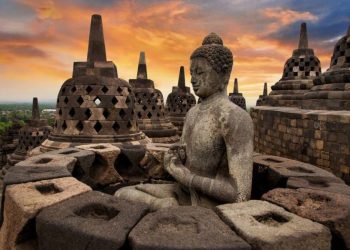Bandung, Indonesia Sentinel — In the hills of West Java, Indonesia, an ancient martial art has been passed down through generations. Known as Benjang, this unique tradition combines elements of wrestling, dance, and music, making it more than just a combat sport. Originating in Ujungberung, Bandung, Benjang is both a test of physical strength and a deeply rooted cultural expression.
The Origins of Benjang
This martial art has been practiced for centuries, with historical records tracing it back to local farming communities. The term “Benjang” is believed to come from the phrase “sasamben budak bujang,” referring to young men who practiced this martial art as a form of self-discipline and entertainment.
Initially, Benjang was performed during village celebrations, such as harvest festivals, weddings, and circumcision ceremonies. Over time, it evolved into a structured combat sport with distinct styles and techniques. By the early 20th century, had become a recognized form of traditional wrestling in West Java.
A Martial Art with a Theatrical Twist

What makes Benjang unique is its combination of combat and performance. Unlike other martial arts, matches begin with Ngibing, a dance ritual that prepares fighters both physically and mentally. This dance consists of four stages:
- Golempang – Movements that mimic rolling on the ground
- Puyuh Ngungkuk – A stance resembling a crouching quail
- Beureum Panon – Intense eye contact to intimidate opponents
- Julang Ngapak – A bird-like flapping motion to symbolize readiness
After this ceremonial dance, the fighters—known as Pebenjang—remove their shirts to demonstrate that they carry no weapons. The match then proceeds as a wrestling bout, where opponents aim to knock each other down using strength and agility.
Benjang is often compared to Sumo wrestling due to its grappling techniques, but it also incorporates elements of Indonesian pencak silat, emphasizing strategy and footwork.
Music as an Integral Part of Benjang

Music plays a crucial role in every performance. Traditional instruments such as the Kendang (drum), Kecrek (cymbals), Terbang (a type of tambourine), and Terompet (trumpet) provide a rhythmic backdrop to the fight. The tempo of the music changes dynamically, responding to the energy of the match and adding to the dramatic tension. This musical accompaniment transforms a simple combat sport into a vibrant cultural spectacle, keeping spectators engaged while preserving the traditional art form.
Variations of Benjang: From Combat to Celebration
Over time, different styles of Benjang emerged, including:
- Benjang Gelut – The wrestling aspect, focused on physical combat.
- Benjang Helaran – A celebratory parade often performed during weddings and circumcision ceremonies.
- Benjang Topeng – A masked dance performance that carries spiritual and philosophical symbolism.
Benjang Helaran, in particular, involves a Wawaran (public announcement) where performers march through the village playing instruments, signaling an upcoming event. This tradition mirrors the role of town criers in medieval Europe.
Read Also:
Decoding the Rajah Sunda: A Sacred Emblem of Protection and Spiritual Balance
Decline and Revival
Benjang’s popularity peaked between 1955 and 1965, with full-day performances featuring Helaran in the morning, Topeng in the afternoon, and Gelut at night. However, by the 1970s, Benjang Gelut faced government restrictions due to concerns over violence between rival groups.
Despite this, Benjang Helaran and Topeng continued to thrive, keeping the art form alive in a more performative context.
In 2018, the Indonesian government officially recognized Benjang as an Intangible Cultural Heritage, revitalizing interest in the tradition. Today, several schools and community groups in Bandung actively teach to younger generations, ensuring its survival.
As Indonesia modernizes, many traditional arts struggle to remain relevant. However, efforts to integrate Benjang into cultural festivals and sports programs have helped maintain its presence. Some martial artists even incorporate techniques into pencak silat competitions, introducing the art to a wider audience.
Benjang is more than just a martial art—it represents community, tradition, and cultural identity. By blending combat with dance and music, it stands as a testament to the rich heritage of West Java. For those interested in experiencing Indonesia’s lesser-known fighting traditions, watching a live performance offers a rare glimpse into a world where strength, rhythm, and history collide.
(Becky)

























